164 Search Results for visual schedule
July 11, 2019
by Carole Zangari -
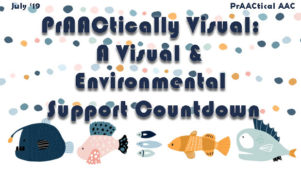
We’re very excited to welcome back AAC SLP Tabi Jones-Wohleber to these pages. You may remember Tabi from the wonderful AAC training materials she shared (11 full modules) or used her Classroom CORE book. Maybe you downloaded her All-In-One Visual Support Tool, used some of her great suggestions about AAC therapy with young children, or were lucky enough to attend one of her conference presentations. Her expertise, generosity, clear command of AAC practices, and commitment to ethical service provision have enriched the AAC lives many of our readers. Today, Tabi launches a new 6-part series on one of our favorite topics: Visual Supports. Let’s get started! :::::::::::::::::::::::::::::::::::::::::::::::::::::::::::::::::::::::::::::::::::::::::::::::::::::::::::::::::::::::::::: Visual and Environmental Supports…4 – 3 – 2 – 1! Visual and environmental supports are the bread-and-butter of many a classroom with students with complex communication (and learning) needs. They may be presented on paper-based or electronic platforms. Understanding the purpose and process... [Read More...]
May 18, 2017
by Carole Zangari -
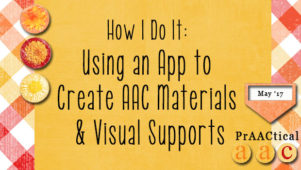
When we think of AAC apps, expressive communication and voice output generally come to mind. But there are other kinds of AAC apps, too, including those that are used to create printable materials. Today, we hear from a clinician who uses this kind of AAC app on a regular basis. Georgia Karavias is a speech language pathologist whose career has centered around working with school-aged children and adolescents who have physical disabilities and communication difficulties. Georgia is passionate about utilizing alternative access methods and inclusive technologies to enable independent communication using AAC systems. She currently works at Scope’s Communication and Inclusion Resource Centre (CIRC) as part of the communication access team in a community capacity building role. In this post, she talks about how she uses AAC and visual supports created with an app developed at her workplace. :::::::::::::::::::::::::::::::::::::::::::::::::::::::::::::::::::::::::::::::::::::::::::::::::::::::: I am a speech pathologist who has worked with children with complex... [Read More...]
February 8, 2017
by Carole Zangari -
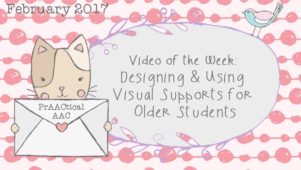
Chances are, you are already using visual supports with your AAC learners. If they aren’t as effective as you imagined they would be, or if you need ideas for how to make them more appropriate for middle and high school students, this video is worth watching. Karine Gleason helps us learn more about making age respectful visual boundaries, cues, and schedules, and gives us tips for fine-tuning our implementation. Many thanks to TASN and the Tri-State Autism Spectrum Disorder Network for making and sharing this video.
December 21, 2016
by Carole Zangari -
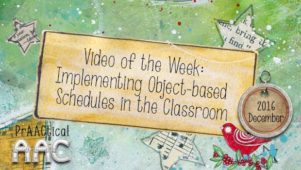
Working with learners who have difficulty transitioning from one activity to the next? Visual schedules are a well-known strategy for supporting transitions, but most of us use pictures to represent the various activities. In some cases, this may not be the best approach. Today’s video describes a case example of a young learner who needed the support of objects. Hear how his team addressed this need and get useful tips for implementation. Be sure to download the handout and supporting resources while you’re there. Many thanks to TASN for making this available. Direct Link to Video: https://www.ksdetasn.org/resources/590
June 29, 2016
by Carole Zangari -

Over the years, we’ve written quite a bit on the prAACtical powers of visual schedules. Activity schedules, known also as mini schedules or task schedules, are great ways to help AAC learners understand what will be happening in a particular activity. Understanding what events will take place helps us all better prepare ourselves for active and appropriate participation in those events. In today’s post, we feature a number of short videos with information on and examples of this strategy. Thanks to the Watson Institute for creating and sharing these videos. Going to the Doctor’s Office Going to the Library Going to Physical Education (PE) Class Going to a Fast Food Restaurant Getting Ready for Bed
January 14, 2016
by Carole Zangari -
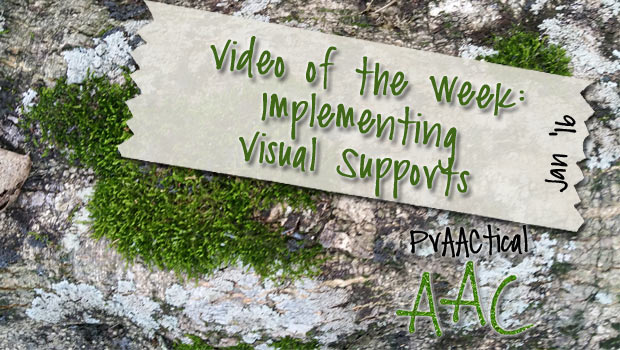
Today, we return to The Watson Institute for information on the implementation of visual supports. Their style of creating brief video explanations focused on specific strategies makes these clips perfect for sharing with colleagues and families. Visual Support Power of Pairing: Reinforcers with Visual Supports Build Your Own Schedule: A Structured Choice Strategy You can browse through previous posts featuring the work from this fine team here.
December 21, 2015
by Carole Zangari -
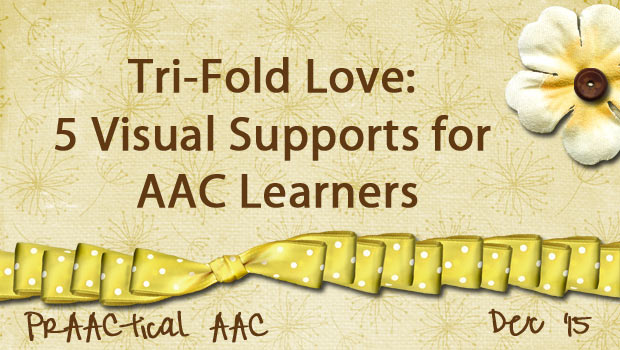
Tri-folds are visual displays that are folded in thirds to make a triangular shaped display that can sit on a desk or table top. Like any other visual support, they can be created to suit a variety of purposes. We love them having these visual reminders out and available for quick use. Here are some we found on the amazing sharing site for Boardmaker Online that you may want to check out. First-Then Tri-fold by Alissa Plaisance Story Grammar Marker by Marcia Piersall Picture Schedules by Stephanie Besio: Side One has symbols for the individual activities. Side Two has ‘finished’ symbols that can be folded over each activity symbol when that task is completed. Work First, Then Play by Clavelle Behavior support by TASN Autism and Tertiary Behavior Supports Do you use this format for visual support with some of the AAC learners in your life? We’d love to hear... [Read More...]
October 5, 2015
by Carole Zangari -
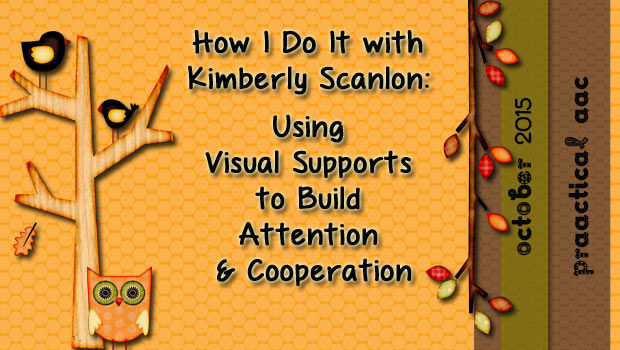
Having solid goals and fun activities is one thing, but being able to connect the two and teach communication and language takes skill. We have the best outcomes when the interventionist knows a variety of strategies that can support the learning outcomes. We’ve written about implementing countdown boards and other visual supports to build attention in the past, and have been gratified to hear from many of you who utilize those strategies. In today’s post, SLP Kimberly Scanlon, owner of Scanlon Speech Therapy, discusses how she implements this strategy and shares her own clever variation. You can download it at the end of the post. :::::::::::::::::::::::::::::::::::::::::::::::::::::::::::::::::: You plan the session. In fact, you over-plan and over prepare. You carefully select materials ensuring they are appropriate, engaging, and motivating for the client. Each activity will be short. Short is key as this student grows restless and losses interest rather quickly. You remove... [Read More...]
May 14, 2015
by Carole Zangari -
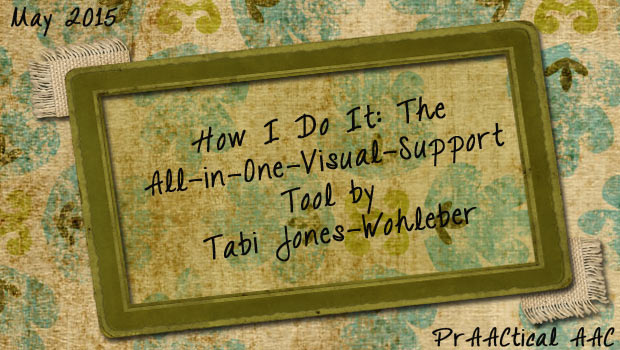
I am constantly in awe of the creativity and generosity of AAC practitioners, particularly those like Tabi Jones-Wohleber who make fabulous materials and share them with colleagues that they’ve never even met. Tabi is an SLP on the AT Team for Frederick County Public Schools in Maryland. A graduate of Penn State University, her career has focused on AAC. Though she works with many schools and addresses a variety of AT needs, most of her time and creative energy is devoted to working with students with the most significant disabilities. In this post, she introduces us to the All-in-One-Visual-Support Tool. You wont want to miss Tabi’s treasure trove of prAACtical materials. :::::::::::::::::::::::::::::::::::::::::::::::::::::::::::::::::::::::::::::::::::: It was a conversation I’d had many times before. A conversation that kept resurfacing in one form or another. It’s the conversation of how to manage all the stuff; all the visuals, all the reinforcers, all the communication tools. The benefit of visual supports to... [Read More...]
March 21, 2014
by Carole Zangari -
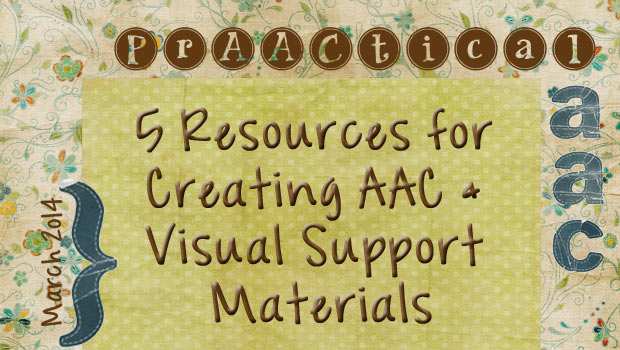
We are fortunate to be prAACticing at a time when there are so many options for creating visual supports and AAC materials. From sophisticated to simple From costly to free From PCS to SmartySymbols and more From one-time purchase to ongoing subscription From computer to mobile device There is a way for prAACtically anyone to make AAC materials, picture schedules, and other visual supports. Here are some of the products we use. Boardmaker Custom Boards SymPrint LessonPix ConnectAbility Visuals Engine









